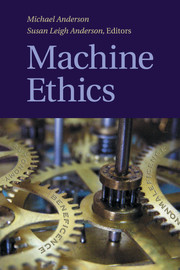Book contents
- Frontmatter
- Contents
- General Introduction
- PART I THE NATURE OF MACHINE ETHICS
- PART II THE IMPORTANCE OF MACHINE ETHICS
- PART III ISSUES CONCERNING MACHINE ETHICS
- PART IV APPROACHES TO MACHINE ETHICS
- Introduction
- 14 Towards the Ethical Robot
- 15 Asimov's Laws of Robotics
- 16 The Unacceptability of Asimov's Three Laws of Robotics as a Basis for Machine Ethics
- 17 Computational Models of Ethical Reasoning
- 18 Computational Neural Modeling and the Philosophy of Ethics
- 19 Architectures and Ethics for Robots
- 20 Piagetian Roboethics via Category Theory
- 21 Ethical Protocols Design
- 22 Modeling Morality with Prospective Logic
- 23 An Integrated Reasoning Approach to Moral Decision Making
- 24 Prototyping N-Reasons
- 25 There Is No “I” in “Robot”
- 26 Prospects for a Kantian Machine
- 27 A Prima Facie Duty Approach to Machine Ethics
- PART V VISIONS FOR MACHINE ETHICS
- References
22 - Modeling Morality with Prospective Logic
from PART IV - APPROACHES TO MACHINE ETHICS
Published online by Cambridge University Press: 01 June 2011
- Frontmatter
- Contents
- General Introduction
- PART I THE NATURE OF MACHINE ETHICS
- PART II THE IMPORTANCE OF MACHINE ETHICS
- PART III ISSUES CONCERNING MACHINE ETHICS
- PART IV APPROACHES TO MACHINE ETHICS
- Introduction
- 14 Towards the Ethical Robot
- 15 Asimov's Laws of Robotics
- 16 The Unacceptability of Asimov's Three Laws of Robotics as a Basis for Machine Ethics
- 17 Computational Models of Ethical Reasoning
- 18 Computational Neural Modeling and the Philosophy of Ethics
- 19 Architectures and Ethics for Robots
- 20 Piagetian Roboethics via Category Theory
- 21 Ethical Protocols Design
- 22 Modeling Morality with Prospective Logic
- 23 An Integrated Reasoning Approach to Moral Decision Making
- 24 Prototyping N-Reasons
- 25 There Is No “I” in “Robot”
- 26 Prospects for a Kantian Machine
- 27 A Prima Facie Duty Approach to Machine Ethics
- PART V VISIONS FOR MACHINE ETHICS
- References
Summary
Introduction
Morality no longer belongs only to the realm of philosophers. Recently, there has been a growing interest in understanding morality from the scientific point of view. This interest comes from various fields, for example, primatology (de Waal 2006), cognitive sciences (Hauser 2007; Mikhail 2007), neuroscience (Tancredi 2005), and other various interdisciplinary perspectives (Joyce 2006; Katz 2002). The study of morality also attracts the artificial intelligence community from the computational perspective and has been known by several names, including machine ethics, machine morality, artificial morality, and computational morality. Research on modeling moral reasoning computationally has been conducted and reported on, for example, at the AAAI 2005 Fall Symposium on Machine Ethics (Guarini 2005; Rzepka and Araki 2005).
There are at least two reasons to mention the importance of studying morality from the computational point of view. First, with the current growing interest to understand morality as a science, modeling moral reasoning computationally will assist in better understanding morality. Cognitive scientists, for instance, can greatly benefit in understanding complex interaction of cognitive aspects that build human morality; they may even be able to extract moral principles people normally apply when facing moral dilemmas. Modeling moral reasoning computationally can also be useful for intelligent tutoring systems, for instance, to aid in teaching morality to children. Second, as artificial agents are more and more expected to be fully autonomous and work on our behalf, equipping agents with the capability to compute moral decisions is an indispensable requirement.
- Type
- Chapter
- Information
- Machine Ethics , pp. 398 - 421Publisher: Cambridge University PressPrint publication year: 2011
References
- 21
- Cited by



